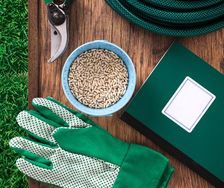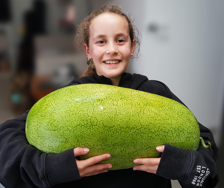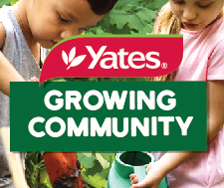Yates Account
Join now
Create a Yates account today!
Sign up to join the Yates Garden Club for monthly e-mails packed with seasonal inspiration, tips for success & exclusive promotions.
Plus if you’re a Garden Club member you can take part in the Yates Growing Community - a blog to share successes, get advice & win prizes in fun challenges along the way!

Forgot password
Enter the email address associated with your account, and we'll email you a new password.

Nature always surprises, and gardens provide plenty of weird and wonderful inspiration. Jaw-dropping secrets are lurking in every corner of our gardens!
Here are some fascinating plant facts, that we bet you didn't know.
- A sunflower isn't just one flower. The sunflower looks like a huge flower head, but the fuzzy brown centre actually contains 1,000–2,000 individual flowers. Each of those individual flowers will produce a sunflower seed.
- There are more microorganisms in a single teaspoon of soil than there are people on earth. It's aliiiiive! That fact might make you feel squirmy and uncomfortable, but microbes are critically important for providing nutrients to plants, which, in turn, feed you.
- Plants really do respond to sound. Talking to plants to help them grow is a well-worn tale, but studies have shown vibration (like music, or the delightfully sweet sound of your own voice) can affect plant growth. The MythBusters (in an admittedly not-so-scientific study), compared a silent greenhouse to one where they piped in a voice soundtrack, and found that plants in the latter grew more.
- Butterflies might be keener to pollinate your weeds than your gorgeous flowers. Colorful blooms help to attract butterflies, but fragrance and nectar are also very important. According to the Smithsonian Institute, many new flower cultivars have been bred for enhanced color and size, but they've often lost their fragrance in the process. They'll attract butterflies from a distance, but the flowers don't deliver on their promise at closer range. Everyday weeds, like dandelions and clovers, don't disappoint hungry butterflies. Consciously choosing old-fashioned or heirloom flower seeds can encourage butterflies to fly your way.
- Have you ever been told carrots help you see in the dark? That's a fib that started during World War II, when the British Air Ministry wanted to keep their brand new radar a secret, so they claimed to be feeding RAF pilots with extra-large portions of carrots, to boost their night vision. Carrots surged in popularity overnight!

- Some of your favorite fruits are actually members of the rose family (Rosaceae). Apples, peaches, pears, cherries, raspberries and strawberries are all Rosaceae species, making them relatives to the long-stemmed, romantic rose.
- The right orchid combination can smell like dessert. "An oncidium hybrid called 'Sharry Baby' smells like chocolate," says George Hatfield, president of the Santa Barbara Orchid Show. "Its 'baking cookie' aroma has made it a winner." In contrast, the cymbidium 'Golden Elf' smells lemony, and Phalaenopsis violacea has a cinnamon scent. "Just like you combine jellybeans to create new flavors, you can combine orchids to create a garden that smells like a dessert buffet," says Hatfield.
- 'Wishbone' flower sounds silly, but it's a real thing. Torenia, a shade-loving annual, has unique, crazy-looking wishbone-shaped stamens protruding from its pretty petals.
- The world's tallest-growing tree is the Coast Redwood (Sequoia sempervirens),which grows along the Pacific Coast of the United States, mainly in California. Interestingly, it's not the world's oldest-growing tree; that award goes to a Bristlecone Pine (Pinus aristata).
- What's the fastest-growing woody plant in the world? Bamboo! It can grow up to 88cm in a single day.
- Where did winemaking originate? Archaeologists have uncovered evidence that grapes were grown to make wine about 8,000 years ago in Mesopotamia (today's Iraq), although the ancient Egyptians were the first to record the process of making wine, about 5,000 years ago.

- What flower was once more valuable than gold? During the 1600s, tulips became so valuable in Holland that their bulbs were literally worth more than gold. This investment craze, known as tulip mania, collapsed and crashed the entire Dutch economy! Fun fact: tulips can keep growing after being cut; as much as an inch per day. How's that for a return on your investment?
- Where do Vanilla beans come from? Vanilla flavoring comes from the pod of an orchid, Vanilla planifolia. Though the pods are called vanilla beans, they're not a bean at all.
- What fruit comes from the bromeliad family? Pineapple! The word 'pineapple' comes from European explorers who thought the fruit combined the look of a pinecone, with flesh like an apple. Pineapples are the only edible members of the bromeliad family.
- Did you know... From a botanical point of view, avocados and pumpkins are fruits, not vegetables, because they bear the plants' seeds. But rhubarb, despite being in your dessert bowl, is very much a vegetable.
- Where did Poinsettias originate from? They're native to Mexico, and were introduced to the United States in 1825 by the first U.S. minister to Mexico, Joel Poinsett (for whom the plant is named).
- Had you noticed that cranberries float? Small pockets of air inside cranberries allow them to stay afloat, but that's not all: cranberries can bounce like little rubber balls if you drop them.

- What flower takes the crown for the largest in the world, and the stinkiest in the world? The Titan Arum (Amorphophallus titanium) is the largest unbranched flower in the world, reaching up to 4.5m tall. The bloom produces a smell like rotting meat, giving it the common name of 'corpse flower'. A similar smell emanates from Rafflesia, another plant that hails from the rainforests of Sumatra. Both plants developed their stenchy scent to attract flies to pollinate them, so they don't need to compete with other blooms to attract butterflies and hummingbirds.
- Did you know... all parts of the oleander (Nerium oleander) are poisonous. Ingesting the leaves of this beautiful Mediterranean flowering shrub can cause gastrointestinal, cardiac and central nervous system problems, that lead to death.
- Confusingly, the vegetables we know as yams in New Zealand aren’t yams at all, according to the rest of the world! NZ yams are actually oca (Oxalis tuberosa), which originates from high altitudes in the Andes, in Peru. In a funny quirk of history, oca seems to have arrived here on whaling ships around the 1850s; everyone here loved it and the ‘yam’ name stuck.
- What flower resembles a dragon? That would be the beloved snapdragon! If you gently squeeze the sides of the flower, the petal dragon's mouth will snap open and closed.
- What's the difference between nectarines and peaches? It's simply that nectarines don't have fuzzy skins. You can even graft peach branches onto a nectarine tree (or vice versa), so you have both types of fruits on a single tree.

- What fruit has its seeds on the outside? Strawberry is the only fruit that forms seeds on the outside. An average strawberry fruit has about 200 seeds.
- Why do we cry when we cut onions? Sulfuric compounds in onions are to blame for bringing tears to your eyes. According to the National Onion Association, chilling the onion and cutting the root end last can reduce the tears.
- What are the oldest living tree species? The Ginkgo (Ginkgo biloba) dates back to about 250 million years ago. Dawn Redwood (Metasequoia glyptostroboides) is also ancient, dating back about 150 million years. Both species were known in the fossil record before living examples were found by botanists.
- The longest-living organisms on earth are...trees. No other organisms come close! The oldest known tree in the world is a Bristlecone Pine named Methuselah. It's estimated to be 4,853 years old, judging by tree-ring evidence.
- Not all nuts are nuts! Peanuts aren't nuts at all, they're legumes...which means they're related to beans and lentils. To make up for it, peanuts contain more protein, niacin, folate, and phytosterols than any true nut, according to the National Peanut Board (yep, there really is a National Peanut Board).
Allelopathic plants don't play nicely with the others in your garden. If you have mysterious areas where nothing really thrives, one of these leafy grouches might be the culprit.
Pruning, Done Right
If you've never pruned before, or you want to brush up on the fundamentals: here's our introduction to pruning. Find out why, when and how to prune, so you can cut with confidence.
Winter Flowers, Trees & Shrubs
Winter doesn't need to be dull! Add colour and fragrance to your winter garden with flowers, flowering trees and shrubs.
Winter Gardening
Here's how you can help protect your garden from chills and frost this winter.












Share
Share this article on social media